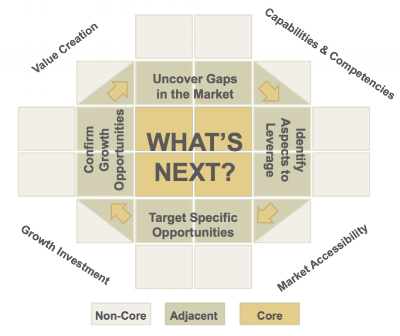Using Market Maps to Identify Partnerships
Strategic partnerships provide companies with needed resources, expertise, and connections to thrive in today’s demanding and competitive business environment. Partnerships allow companies to focus on their core competencies while still providing comprehensive solutions. However, finding the right partners is difficult and extremely important. Market Opportunity Maps can help you uncover and determine which are the best potential partners for your business.
What is a Market Opportunity Map?
A market map is a structural representation of the market environment in which your product or service operates in. A well-constructed market map can be insightful, flexible, and will serve many strategic needs. It can be utilized to develop product and portfolio strategy, competitive strategy, identifying partnership and acquisition candidates, and providing feature level customer insights. In this example of a market opportunity map for Corporate Governance, there are two high-level tiers, Research & Advisory and Investment Tools and Data. As the map moves to the right, to Tiers 3 and 4 it gets more and more specific at the feature level.
The intention of a market opportunity map is to show the complete ecosystem that your product or service plays in, who is playing in each segment, and with what. The job of the mapmaker is to capture the entire ecosystem and align these services, at the feature level, from one competitor to another. In the language of the market map these are called Tiers. The typical market map has Four Tiers (above figure), each at an increasingly granular level and describing a more detailed classification of a product segment.
Market Opportunity Map for Partnerships
Using the Market Opportunity Map to generate partnership screening criteria is easy once the basic map is complete and competitors are mapped to it. During the process of gathering information about the competitors’ products and services, we uncover information about competitors’ business models, sales channels, and customers. In addition to the financial reasons to form a partnership the map allows you to look at synergistic attributes. We have identified five (field sales, client base, brand reputation, channels, and integration with existing products.
Once you have the Market Opportunity Map, partnership and/or acquisition candidate screening becomes easy to visualize. The first step is to identify the segments where a partner would help you grow. In this chart if you are weak in Research & Advisory and the market is trending toward that you now see which companies you might be able to approach or acquire and what you are getting.
Next, we use screening questions to do a first pass on the competitive list built into the map. (Remember, all of this information was collected during the creation of the map.) These screening questions include:
1. Does the target company play in the part of the market that is attractive?
2. Is the target company aligned with the competitor’s vision and goes?
3. Is the target company’s business model strong and sustainable?
4. Do the target company’s customers overlap our competitor’s customers?
5. How advanced are the target companies technologies, products and services?
The result is a matrix that weeds out companies not interesting in the first pass and adds in the added dimension of immediate or observable synergies.
You now have a ranked list of which companies to approach and why. The next step is some commercial due diligence.
Market Opportunity is a Versatile Tool
The market map is a versatile tool and with the right collection of data will provide many answers to strategic questions you might have. If you are interested in building a market map for your company message me through LinkedIn. I’m happy to share other examples to help you construct your map.
Happy Mapping!














